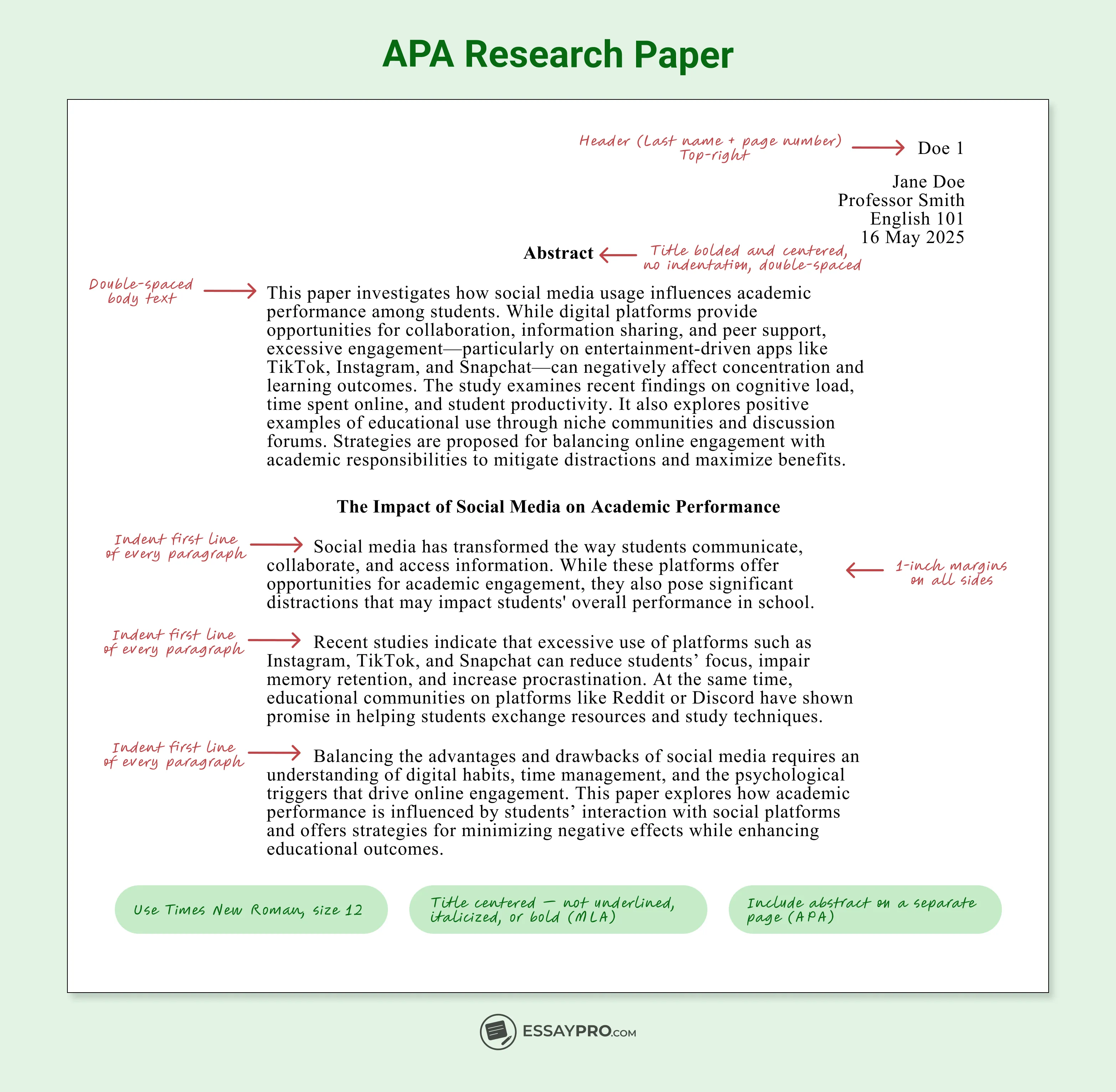The usual first step of writing a research paper is mostly panic. But once you get past that initial phase of staring at the screen, wondering how to even start approaching all of it, you find out that it's a lot easier than it seemed at first. Before you start writing, you have to understand what a research paper is and what it takes to write one. And yes, you'll quickly realize that you can absolutely do it without pulling three all-nighters in a row. Here's how to get started:
- Understand the requirements
- Choose the right topic
- Check the background information
- Develop your thesis statement
- Gather solid evidence
- Make an outline
- Write your first draft
- Proofread everything
This guide will explain each step in detail so you have no more questions about the process. If by the end of this article, you're still thinking, 'I need to pay someone to write a research paper,' you can always rely on EssayPro's expert academic writers to help you every step of the way. Our professional guidance is just a few clicks away.
How Long Should a Research Paper Be?
There is no right answer to the question about the length of a research paper. It all depends on the assignment's requirements and on what academic level you're writing at. In most cases, it ranges between 4,000 and 6,000 words, but we also see shorter papers with 1,500 words and longer ones with about 10,000. The latter is usually for graduate-level academic research papers, especially if original research and detailed data are involved.
However, meeting the word count is not all it takes to write a research paper. You should always focus on quality over quantity - a clear argument that stays on track will always work better than long paragraphs full of unnecessary words.


How To Write a Research Paper in 12 Steps
Now, let's go through the concrete steps you should follow when writing a research paper so you understand everything in detail:
- Understand the assignment
- Choose the right topic
- Do preliminary research
- Write your thesis statement
- Find strong evidence
- Create a research paper outline
- Draft your ideas
- Open with a solid introduction
- Build body paragraphs
- Write your conclusion
- Cite the sources
- Proofread and edit
Before getting into the writing details, here's an example format.

Understand The Assignment
Before you start a research paper, you need to make sure you fully understand what your instructor requires from you. You don't want to wake up to lost grades because you missed something important.
- Check the page count and formatting guidelines
- Don't assume, just ask if something isn't clear
- Go back to the assignment sheet for reference
Choose The Right Topic
Don't just go with the first idea you find interesting. Picking the right topic will make the process of writing a research paper easier to handle and even more enjoyable.
- Choose something specific enough
- Check if there's enough existing research
- Go with something you're passionate about
Do Preliminary Research
A literature review is necessary if you want to write credible academic papers. You have to get a clear understanding of your research paper topic because if there's not enough credible research around it, it might be time to think of something else.
- Use encyclopedias, credible journals, or educational sites
- Note important terms and common themes
- Understand the conversation about the topic
Write Your Thesis Statement
If you're wondering how to start a research paper, the first part you should focus on is your thesis statement. Your entire research paper will be centered around it, so it's best to spend a bit more time developing it. Remember, everything you write will come back to this one sentence.
The thesis should be very clear and focused. It needs to state your argument or the answer to the research question, so the reader knows where your paper is headed from the start. You can learn more about how to make abstract in research paper so you know how to start strong.
Find Strong Evidence
All that preliminary research you did before was just the beginning. Once you develop your thesis, you need to start backing it up with a lot of solid evidence. Each point you make in your paper must be proved with hard facts. Look for credible sources that actually support the point you're making, and avoid shady blogs or non-peer-reviewed articles.
Create A Research Paper Outline
A well-organized research paper outline helps you stay on track during the writing process. It doesn't have to be fancy or perfect; you just need to think about what goes where and how your ideas are going to flow. Check the requirements to see if you need to write an MLA or APA research paper outline. Either way, it should include:
- Introduction to your thesis
- A few main points, each in its own section
- Supporting evidence under each point
- A conclusion that wraps things up
Draft Your Ideas
The first draft is needed just so you can get your thoughts down on paper (or page). Don't worry about it being organized or looking pretty; just go back to your outline and write everything that comes to mind. You'll have time to tidy up the paper's structure later. Look up exactly how to write an introduction for a research paper so you don't have to scramble for instructions halfway through.
Open With A Solid Introduction
Your research paper introduction is practically the first thing the reader sees, so it should set up the topic right away.
- Open with a question, stat, or short anecdote
- Give just enough context to set things up
- Make sure it leads to your central idea
Build Body Paragraphs
The body of your research paper is where you use all that research to lay out your arguments and support them. Each paragraph should focus on a single idea and back it up with solid evidence.
- Start each paragraph with a topic sentence
- Add the supporting evidence
- Explain why it all matters
- Connect everything back to your thesis
Write Your Conclusion
The research paper conclusion is the word you're leaving the reader with. When finishing your paper, you should:
- Restate your thesis
- Go back to the most important points without repeating them
- Leave the reader with something to think about
Cite The Sources
You need to give credit where it's due when you're using someone else's work while writing your research paper. Two formatting styles are used most commonly: APA and MLA. It's best to check what your professor requires before you move on to the works cited so you don't lose marks over incorrect formatting.
Proofread And Polish
You've made it! This is the last step before you hit submit. Read the whole thing carefully, even out loud, if you can. Fix grammatical errors and catch any awkward phrasing. It helps if you get a second opinion, too, because a fresh pair of eyes will notice things you might have missed. Make sure everything flows logically and that your thesis still holds the paper together.
Wrapping Things Up
A research paper isn't just about meeting the word count with baseless arguments. The paper starts doing what it's supposed to do only when each part flows into the other and connects back to your main point. Do that, and you will make sure you're actually making a case for your research.
Deadlines don't always make things easy for us, though. If things start to feel rushed or off track, you can always connect with EssayPro experts and delegate your tasks to them. Just ask, 'Do my research paper for me.' This way, you can get professional writing guidance so you can deliver what the assignment actually asks of you.
Deadlines Getting The Best Of You?
Connect with a professional writer in just a few minutes so you can stop stressing about your academic life.
FAQ
What Is a Research Paper?
A research paper is a piece of academic writing that digs into a specific idea using credible sources for evidence. Such a paper allows you to form arguments and back them up, so you show you've done the work.
What Does a Research Paper Look Like?
A typical research paper includes an introduction with a thesis statement, several body paragraphs with supporting evidence, and a conclusion that ties everything together. It also includes citations and a bibliography or a reference list.
How to Start a Research Paper?
Once you're sure you understand the assignment and have done enough background research, you should start writing your thesis statement and build the introduction around it. Your introduction should give the reader enough context so they get a basic understanding of your topic.
How to Write a Thesis for a Research Paper?
A good thesis statement is clear and specific. It tells the reader exactly what the paper is about and why it matters. Your thesis is just one sentence, so it needs to count. Make sure all of your points and arguments go back to this sentence.
How to Write a Research Paper Outline?
Start with a simple structure. The outline should include your introduction with a thesis, several body paragraphs with supporting evidence, and a conclusion that brings everything together. The main thing at this point is to stay organized; you can polish things later on.

Daniel Parker
is a seasoned educational writer focusing on scholarship guidance, research papers, and various forms of academic essays including reflective and narrative essays. His expertise also extends to detailed case studies. A scholar with a background in English Literature and Education, Daniel’s work on EssayPro blog aims to support students in achieving academic excellence and securing scholarships. His hobbies include reading classic literature and participating in academic forums.
- Dange, R. (n.d.). Mastering the Art of Research Paper Writing: A Comprehensive Guide. Cambridge Centre for International Research (CCIR) | Knowledge Network. https://cambridge-research.org/blogs/how-to-write-a-research-paper/
- The Structure of an Academic Paper. (n.d.). https://communicate.gse.harvard.edu/files/commlab/files/_structure_of_a_paper.pdf







